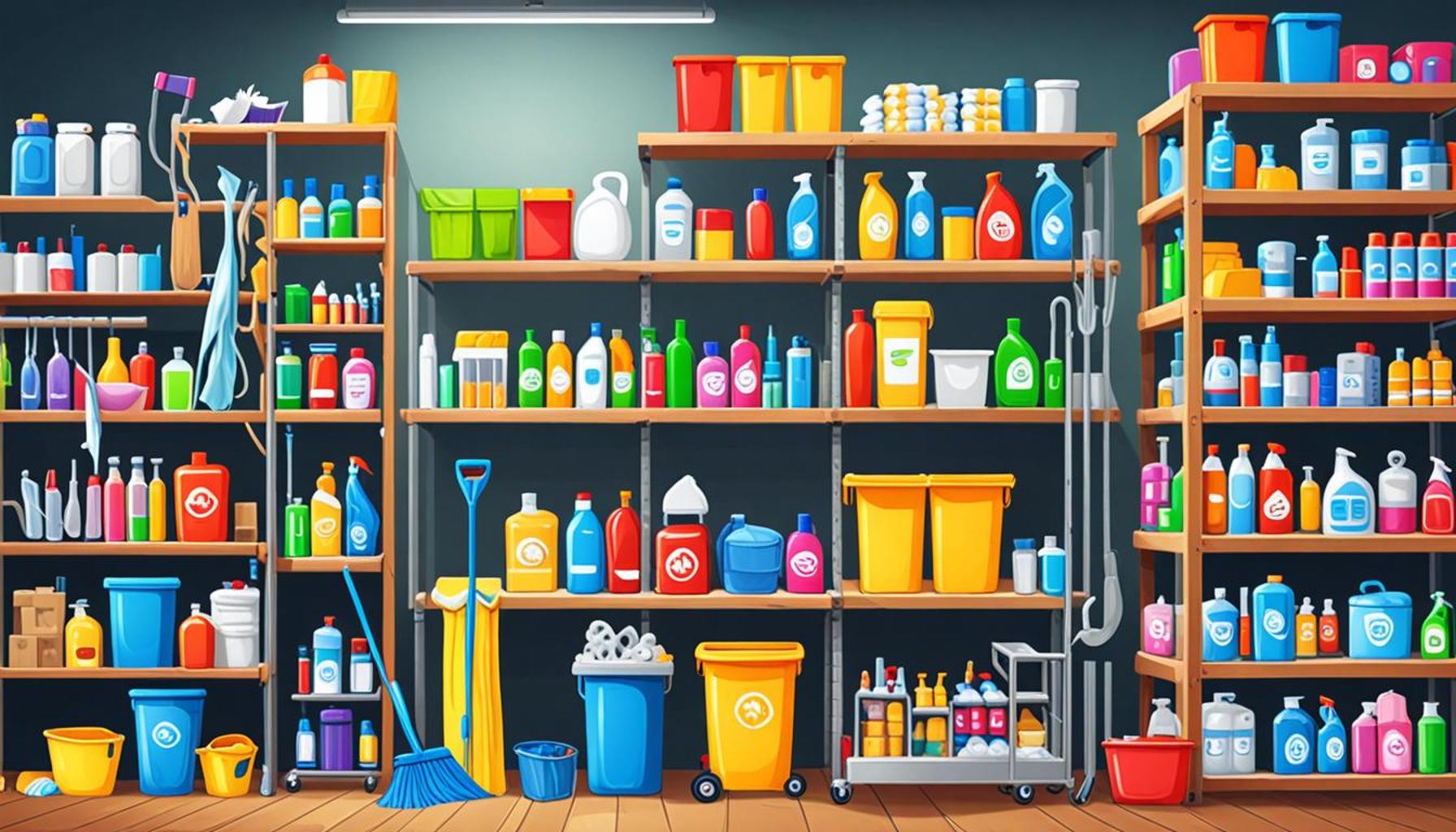Creating an Efficient Inventory System for Cleaning Supplies and Equipment Management

The Importance of Efficient Cleaning Supply Management
Managing cleaning supplies and equipment effectively is crucial for any organization, whether it’s a small office or a large facility. An efficient inventory system not only ensures you have the right products on hand but also promotes overall productivity and cost savings. Without a streamlined approach, facilities can quickly spiral into chaos, leading to negative impacts not just on operations but also on employee morale.
Consider how a restaurant would falter if it ran out of basic cleaning solutions or equipment like mops and brooms. The potential for unsanitary conditions can damage a business’s reputation, lead to health code violations, and ultimately hurt the bottom line. Here are some common challenges that emerge without proper inventory management:
- Overstocking or understocking supplies: Overstocking can tie up valuable capital, while understocking can lead to disruptions in day-to-day operations.
- Increased labor costs due to inefficient restocking processes: Employees may spend excessive time searching for products or coordinating emergency restocks.
- Wasted resources from expired or damaged products: Cleaning products often have a shelf life, and without proper tracking, organizations risk discarding unused, shelved items.
Implementing a well-structured inventory system can transform how your organization operates. Key features to look for include:
- Real-time tracking: Utilize software solutions that allow for the consistent monitoring of stock levels, ensuring that supplies can be replenished before they run out. This is increasingly relevant in high-traffic environments like schools, where cleaning needs fluctuate.
- Automated alerts: Many modern systems offer notifications when stocks are dipping below a predetermined threshold. This proactive approach helps maintain efficiency and prevents unexpected shortages.
- Reporting capabilities: Robust inventory systems provide detailed reports on usage patterns and trends, allowing organizations to identify high-use items, optimize order quantities, and even uncover opportunities to negotiate better pricing with suppliers.
In sectors such as healthcare, where cleanliness and hygiene are paramount, managing cleaning inventory effectively becomes even more vital. Hospitals require certain chemical agents and personal protective equipment, which must be available at all times to safeguard against contamination.
By prioritizing these features, organizations can mitigate common pitfalls related to cleaning supply management. Streamlining these processes enables a smoother operational flow, supporting both employee productivity and high service quality. Moreover, a well-managed inventory can lead to substantial long-term savings, enhancing the overall effectiveness of an organization.
In the following sections, we will explore the specific steps necessary to create an effective inventory management system tailored for cleaning supplies and equipment. By doing so, you can ensure your organization runs smoothly and efficiently, ultimately boosting performance and elevating service quality.
DISCOVER MORE: Click here to learn about eco-friendly cleaning
Essential Steps for Developing an Effective Inventory System
Creating an efficient inventory system for cleaning supplies and equipment management involves a strategic approach that integrates technology, organizational practices, and employee training. To ensure the effectiveness of this system, it is paramount to understand the essential steps that organizations must take. Here, we break down these steps into actionable strategies that can lead to success.
1. Assess Current Inventory Practices
The first step to building an efficient system is to conduct a thorough assessment of your current inventory practices. This assessment includes evaluating current stock levels, reviewing the frequency of restocking, and determining how supplies are tracked. Are current methods resulting in overstock or stockouts? Gathering this data can provide critical insights into inefficiencies that need addressing.
2. Categorize Cleaning Supplies and Equipment
Next, it’s essential to categorize cleaning supplies and equipment. Organizing these items into defined categories—such as disinfectants, surface cleaners, and personal protective equipment—simplifies tracking and management. Utilizing an established categorization system allows for easier navigation of supplies, making it simpler for employees to locate what they need quickly.
3. Implement an Inventory Management Software
In today’s digital age, adopting an inventory management software solution is key to creating efficiency. Such software should enable:
- Real-time inventory updates: This feature helps track the usage and levels of supplies as they are consumed, minimizing the risks of running low unexpectedly.
- Automated reorder points: By setting predefined levels for reordering, the system can place orders automatically, ensuring stocks are replenished promptly.
- Stock history reports: This functionality aids in analyzing usage trends over time, allowing for more informed purchasing decisions. Organizations can understand which products are used most frequently and adjust orders accordingly.
Choosing the right software can depend on the size of your organization and your specific cleaning needs. For smaller entities, budget-friendly options may suffice, while larger operations may benefit from comprehensive systems tailored to complex environments.
4. Train Employees on Inventory Procedures
An efficient system is only as effective as the personnel managing it. Therefore, training employees on inventory management procedures is critical. Training sessions should cover:
- How to use the inventory system: Clear guidelines on navigating the software can lead to higher compliance and effective usage.
- Best practices for product handling: Educating staff about proper handling and storage of supplies can reduce damage and waste.
- Reporting discrepancies: Employees should know how to communicate issues regarding inventory discrepancies to promote timely resolutions.
By investing time in training, organizations ensure their inventory system operates smoothly, maximizing employee engagement and minimizing costly errors.
As organizations embrace these essential steps for developing an inventory management system, they can pave the way for a more streamlined and efficient operation that ultimately supports their broader objectives. In the next segment, we will explore the significance of selecting and maintaining supplier relationships, a critical aspect of effective inventory management.
| Category | Description |
|---|---|
| Real-Time Tracking | Ensures that inventory levels are monitored continuously, preventing shortages. |
| Data-Driven Insights | Utilizes analytics to optimize ordering processes and improve supply chain efficiency. |
| Cost Efficiency | Reduces wastage and unnecessary purchases by analyzing consumption rates. |
| User-Friendly Interface | Simplifies the process of inventory management, making it accessible for staff. |
Creating an efficient inventory system for cleaning supplies and equipment management is crucial for maintaining operational efficiency and hygiene standards. The ability to track supplies in real-time can significantly reduce the risk of running out of essential items, thus preventing operational delays. Moreover, utilizing data-driven insights allows managers to make informed decisions, improving both inventory turnover rates and overall supply chain efficiency.Additionally, a focus on cost efficiency helps businesses minimize wastage by accurately forecasting which supplies will be needed based on usage patterns. This leads to smarter purchasing practices that can save substantial amounts over time. Finally, a user-friendly interface is imperative; it ensures that team members on the ground can easily manage their inventory without needing extensive training or technical knowledge. Together, these features equip organizations with the tools necessary for successful cleaning operations and management.
DISCOVER MORE: Click here for essential tips
Building Strong Supplier Relationships
As organizations lay the groundwork for an effective inventory system, another crucial aspect is the development of robust relationships with suppliers. Engaging suppliers as strategic partners not only ensures timely access to quality products but also fosters an environment of mutual trust and reliability. Having reliable suppliers in your corner can significantly impact the efficiency of your cleaning supplies and equipment management system.
1. Evaluate and Select Quality Suppliers
The selection of suppliers should not be taken lightly. In evaluating potential partners, organizations should consider factors such as:
- Product Quality: It’s essential to source cleaning supplies that meet industry standards and regulations. Quality products lead to better cleaning outcomes, reducing the need for repetitive cleaning and unnecessary reordering.
- Delivery Reliability: Assess supplier track records for fulfilling orders on time, which is critical for maintaining stock levels and avoiding disruptions in cleaning operations.
- Cost Competitiveness: While cost should not be the sole factor, obtaining competitive pricing can significantly influence operational budgets. Evaluating the overall value, including service and reliability, is vital.
By conducting thorough due diligence, organizations can align themselves with suppliers that not only provide products but also align with their broader goals and values.
2. Negotiate Favorable Terms
Once quality suppliers have been identified, it’s imperative to negotiate favorable terms that can benefit both parties. Consider the following:
- Volume Discounts: Suppliers may offer discounts based on the volume of products ordered. This can lead to cost savings that can be redirected towards other operational expenses.
- Flexible Payment Terms: Establishing terms that allow for flexibility in payment can ease cash flow, especially for organizations undergoing fluctuations in demand.
- Returns and Exchanges Policy: Negotiating a clear policy for returns or exchanges due to product defects will protect your investments and facilitate resource management.
Cultivating a win-win scenario through negotiation can lay the foundation for a solid long-term relationship between your organization and suppliers.
3. Monitor Supplier Performance
Continuous evaluation of supplier performance is essential to maintaining an efficient inventory system. Implementing a systematic process to monitor suppliers can help organizations stay proactive in their inventory management. Key performance indicators (KPIs) to evaluate might include:
- On-time Delivery Rates: Tracking the percentage of orders delivered on time can highlight reliability and help assess the need for alternative suppliers.
- Quality Consistency: Regularly assessing product quality against agreed standards can prevent potential issues that may arise due to subpar supplies.
- Customer Service Responsiveness: Gauge how effectively a supplier communicates and resolves issues, as good customer service is integral to reliable supply chain management.
Establishing a feedback mechanism not only improves communication with suppliers but also strengthens the partnership over time, allowing both parties to adjust as needs evolve.
4. Foster Communication and Collaboration
Strong supplier relationships thrive on effective communication. Organizations should emphasize open lines of communication to facilitate collaboration. This can include:
- Regular Check-Ins: Schedule periodic meetings or calls to discuss performance, address concerns, and explore new products that may enhance your cleaning operations.
- Shared Forecasting: Engaging suppliers in forecasting demands allows them to prepare better for future orders, creating a smoother inventory flow.
- Joint Problem Solving: By working together to address challenges, both parties can develop innovative solutions that contribute to a more resilient supply chain.
These collaborative efforts not only enhance the efficiency of inventory management but can also foster a sense of partnership that translates into better service and stability for all involved.
As organizations navigate these strategies for selecting and maintaining supplier relationships, they reinforce the backbone of an efficient inventory system, contributing further to overarching operational success.
DISCOVER MORE: Click here to find out how preventive maintenance can improve your indoor air quality</p
Conclusion
In the realm of cleaning supplies and equipment management, establishing an efficient inventory system is paramount for operational success. By blending technology with strategic supplier partnerships, organizations can streamline their operations, minimize costs, and enhance overall productivity. The journey begins with a comprehensive understanding of inventory needs and evolves through careful supplier selection, negotiation of favorable terms, vigilant performance monitoring, and fostering open communication.
The integration of an automated inventory management system not only reduces manual errors but also provides real-time insights into stock levels, helping organizations make informed purchasing decisions. Additionally, nurturing relationships with suppliers allows for better price negotiation, ensures consistent quality, and paves the way for collaborative problem-solving, which is essential in today’s fast-paced market.
As businesses seek to refine their inventory management practices, it’s important to remember that this is a dynamic process that requires ongoing assessment and adaptation. Organizations should consider the evolving market landscape, sustainability concerns, and innovations in cleaning products and equipment when shaping their inventory strategies. Investing in training for staff can also significantly improve handling practices, ultimately leading to safer and more effective cleaning operations.
In summary, an efficient inventory system for cleaning supplies and equipment management is not only beneficial for maintaining cleanliness and hygiene but also acts as a catalyst for operational efficiency. As organizations embrace these strategies, they position themselves at the forefront of effective management, ready to tackle the challenges of tomorrow.


